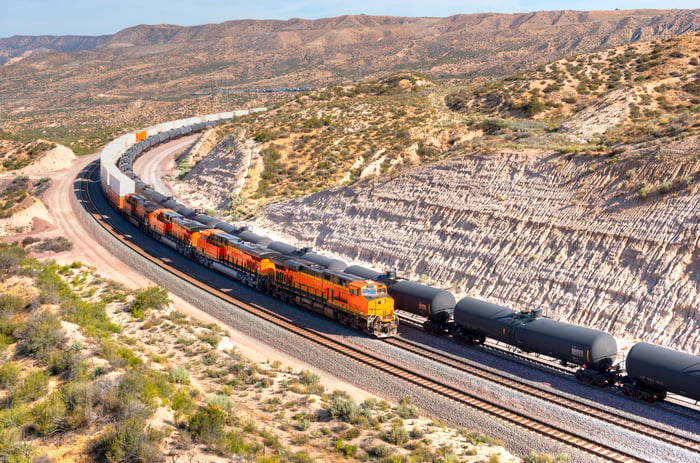Brookfield Infrastructure Partners (BIP 2.04%) is one of the largest owners of infrastructure assets in the world. From toll roads in India, Brazil, and Peru to ports throughout Europe, Asia, South America, and Australia, along with several other assets in between, the company owns a diverse set of backbone infrastructure assets that generate steady cash flow, underpinned by long-term contracts and regulatory frameworks. Those two factors support not only the company's cash flow but also its growth projections.
In fact, the company estimates that a combination of inflationary price increases, volume upside from GPD growth, and capital projects under way will drive 6% to 9% annual organic growth in its funds from operations, which should fuel 5% to 9% annual distribution growth. Meanwhile, a steady diet of acquisitions could push those numbers meaningfully higher in the future.
But not all that growth is a sure thing. Here's a look at what might cause the company to underperform expectations.

Image source: Getty Images.
Inflation might not help as much as hoped
One of the three pillars of Brookfield Infrastructure Partners' organic growth projection is the ability to capture inflationary price increases through regulatory frameworks and long-term contracts. For example, the company recently acquired a natural gas transmission business in Brazil from oil giant Petrobras (PBR 0.26%). One of the draws of that deal was that the company could collect steadily growing cash flow because Petrobras locked 100% of the system's capacity up under long-term ship-or-pay gas transmission agreements that come with full inflation indexation. That means Brookfield can increase rates with inflation, enabling cash flow to grow steadily.
Overall, 75% of its EBITDA has upside to inflationary price increases in the future. That's noteworthy, because Brookfield Infrastructure Partners estimates that inflation will drive 3% to 4% annual growth in its funds from operations. That's a nearly half its growth projection, which could become a problem if inflation doesn't rise as much as expected. For example, Brazil's inflation rate recently hit a 10-year low of 3.6%, which was below expectations of 3.77%. If inflation rates in places like Brazil and India were to come in well below expectations in the future, it could cause Brookfield's cash flow to grow slower than expected.
Volume growth doesn't materialize
Another major driver of Brookfield Infrastructure Partners' organic growth forecast is volume upside from GDP growth, which it estimates will add 1% to 2% annually to its earnings. That's because 30% to 35% of its EBITDA, primarily in its ports and toll road business, will benefit from higher volumes as the global economy improves.
That said, volume exposure can be a two-edged sword. That's because many of these investments are in emerging-market economies such as Brazil, which are prone to deep recessions. This volume growth might therefore not materialize and could go down if economic conditions deteriorate. That happened to its transportation segment in the second quarter of last year, where funds from operations dipped 1.9% in part because of lower vehicle traffic on its Brazilian toll road business as a result of that country's deepening recession and political crisis. While the company would go on to more than offset last year's weakness thanks to acquisitions, a future global recession could cause volumes to tumble, causing Brookfield's volume-driven earnings growth projection to miss the mark.

Image source: Getty Images.
Competition for acquisitions heats up
While organic growth is an important driver for Brookfield Infrastructure Partners, acquisitions are what has taken it to another level in the recent past. In fact, since going public in 2009, the company has delivered 12% compound annual growth in funds from operations, in part from its ability to acquire high-quality assets on a value basis. That focus on value led the company to make several acquisitions in Brazil last year, as it sought to take advantage of the country's economic woes to acquire premier assets at a compelling price, such as its deal to buy Petrobras' gas transmission business.
But competition for infrastructure investments is heating up these days. Brookfield noted in last quarter's shareholder letter that "the private market for infrastructure continues to grow, and there is substantial liquidity and demand for both infrastructure equity and debt investments." For example, private-equity juggernaut Blackstone Group (BX) recently launched a $40 billion infrastructure investment vehicle and has already secured a $20 billion anchor investment from Saudi Arabia. With leverage, Blackstone expects to invest $100 billion in infrastructure projects in the coming years. While most of Blackstone's investments will be in the U.S., it underscores the trend of increasing competition in the space, which could make it harder for Brookfield to make acquisitions on a value basis. That could cause the company to overpay for deals, take on more risk, or slow its purchasing pace, all of which could lead to weaker growth in future years.
Investor takeaway
Brookfield Infrastructure Partners believes that it can deliver high-single-digit organic earnings and distribution growth over the next several years, with the potential for double-digit growth when factoring in acquisitions. However, those projections require steady inflation, a growing global economy, and the ability to acquire premium assets for a good price. There's a risk that any one of those three factors might not come to fruition, which is something bullish investors need to keep in the back of their mind because it could derail the bull case.





